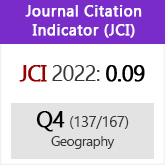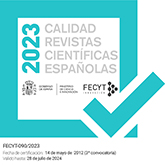Fertility in the Spanish provinces in historical perspective
DOI:
https://doi.org/10.3989/estgeogr.0462Keywords:
fertility, marital fertility, nuptiality, Princeton index, demographic transition, Spain, regression analysis, cluster analysisAbstract
Spain participates in the same trends that are common to the rest of Western Europe followed by the course of fertility, while showing some peculiarities. The first transition of fertility in Spain was a fairly heterogeneous in terms of territorial, as the Spanish provinces show “tempos” quite distinct. The opposite happens with the second transition, which shows a great homogeneity, especially in regard to turning points in the index. The most influential factor in the decline of the total fertility rate until 1975 is marital fertility, as shown by the regression analysis. After 1975, it still shows that over half of the provinces (26) the general decline in fertility is explained by the decline of fertility within marriage, only in 9 the nuptiality explains the reduction in the overall rate, while in the rest the two factors work together.
Downloads
References
Arango, J. (1980): “La teoría de la transición demográfica y la experiencia histórica”, Revista Española de Investigaciones Sociológicas, 10, pp. 169-198.
Andorka, R. (1978): Determinants of Fertility in Advanced Societies, London, Methuen.
Bongaarts, J. (1978): “A Framework for Analyzing the Proximate Determinants of Fertility”, Population and Development Review, 14, pp. 105-132. doi:10.2307/1972149
Bongaarts, J. (1983): “The Proximate Determinants of Natural Marital Fertility”. In: Bulatao, R. A. and Lee, R. D. (eds.), Determinants of Fertility in Developing Countries, New York, tome I, pp. 103-138.
Coale, A. J. and Treadway, R. (1986): “A Summary of the Changing Distribution of Overall Fertility, Marital Fertility, and the Proportion Married in the Provinces of Europe”. In: Coale, A. J. and Watkins, S. C. (eds.) The Decline of Fertility in Europe, Princeton, Princeton University Press, pp. 31-79.
Coale, A. J. And Watkins, S. C. (eds.) (1986): The Decline of Fertility in Europe, Princeton.
Delgado, M. (2000): “Los componentes de la fecundidad: su impacto en la reducción del promedio de hijos por mujer en España”, Economistas, 86, pp. 23-34.
Delgado, M., Meil Landwerlin, G. and Zamora López, F. (2008): “Spain: Short on children and short on family policies” Demographic Research, vol. 19, 27, pp. 1059-1104. doi:10.4054/DemRes.2008.19.27
Devolder, D., Nicolau, R., Panareda, E. (2006): “La fecundidad de las generaciones españolas nacidas en la primera mitad del siglo XX. Un estudio a escala provincial”, Revista de Demografía Histórica, XXIV, 1, segunda época, pp. 57-89.
Diez Nicolas, J., Miguel, J. de (1981): Control de natalidad en España, Barcelona.
Fernandez Cordón, J. A. (1986): “Análisis longitudinal de la fecundidad en España”, Actas del Simposio Internacional sobre Tendencias demográficas y planificación económica, Ministerio de Economía y Hacienda, Madrid, pp. 49-75.
Frejka, T. and Sardon, J.-P. (2004): Childbearing Trends and Prospects in Low-Fertility Countries. A Cohort Analysis, Kluwer Academic Publishers, Dordrecht
Knodel, J. and Van De Walle, E. (1979): “Lessons from the Past: Policy Implications of Historical Fertility Studies”, Population and Development Review, 5, 2, pp. 217-245. doi:10.2307/1971824
Kohler, H.-P., Billari, F. C., Ortega, J. A. (2002): “The Emergence of Lowest-Low Fertility in Europe During the 1990s”, Population and Development Review, 28, 4, pp. 641-680. doi:10.1111/j.1728-4457.2002.00641.x
McDonald, P. (2006): “Low Fertiliy and the State: The Efficacy of Policy”, Population and Development Review, 32, 3, pp. 485-510. doi:10.1111/j.1728-4457.2006.00134.x
Leasure, W. (1963): “Factors involved in the Decline of Fertility in Spain 1900-1950”, Population Studies, 16, 3, pp. 271-285. doi:10.2307/2172782
Lesthaeghe, R. (1983): “A Century of Demographic and Cultural Change in Western Europe: An Exploration of Underlying Dimensions”, Population and Development Review, 9, 3, pp. 411-435. doi:10.2307/1973316
Lesthaeghe, R. (1977): The Decline of Belgian Fertility, 1800-1970. Princeton University Press, Princeton.
Livi-Bacci, M. (1978): “La fecundidad y el crecimiento demográfico en España en los siglos XVIII y XIX” en Glass, D.V. y Revelle, R. Población y cambio social, Madrid, pp. 176-187.
Livi-Bacci, M. (1987): “La Península Ibérica e Italia en vísperas de la transición demográfica”. En: PÉREZ MOREDA, V. y REHER, D. S. (comps.) La demografía histórica en España, Madrid, Anaya.
Nadal, J. (1984): La población española (Siglos XVI a XX), Barcelona.
Perez Moreda, V. (1984): “Evolución de la población española desde finales del Antiguo Régimen”, Papeles de Economía Española, 20, pp.20-38.
Rodriguez Osuna, J. (1985): Población y territorio en España, Madrid.
Van De Kaa, D. J. (1987): “Europe’s Second Demographic Transition”, Population Bulletin, 42, 1, pp. 1-57. PMid:12268395
Van De Kaa, D. J. (1998): “Postmodern Fertility Preferences: from Changing Value Orientation to New Behaviour”, Working Papers in Demography, 74, The Australian National University.
Van De Kaa, D. J. (1999): “Without Maps and Compass? Towards a New European Transition Project”, European Journal of Population, 15, pp. 309-316. doi:10.1023/A:1006348220615
Downloads
Published
How to Cite
Issue
Section
License
Copyright (c) 2009 Consejo Superior de Investigaciones Científicas (CSIC)

This work is licensed under a Creative Commons Attribution 4.0 International License.
© CSIC. Manuscripts published in both the printed and online versions of this Journal are the property of Consejo Superior de Investigaciones Científicas, and quoting this source is a requirement for any partial or full reproduction.All contents of this electronic edition, except where otherwise noted, are distributed under a “Creative Commons Attribution 4.0 International” (CC BY 4.0) License. You may read here the basic information and the legal text of the license. The indication of the CC BY 4.0 License must be expressly stated in this way when necessary.
Self-archiving in repositories, personal webpages or similar, of any version other than the published by the Editor, is not allowed.
















